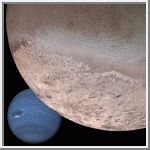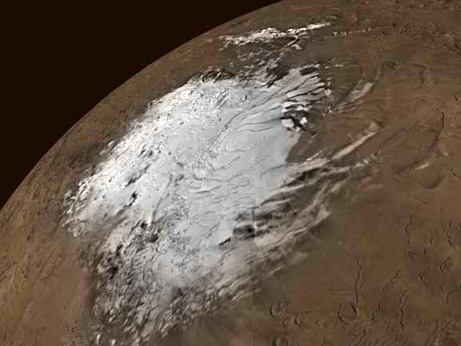|
Global Warming on
Triton
28 Jun 1998
http://www.scienceagogo.com/news/19980526052143data_trunc_sys.shtml

Picture courtesy of
NASA/JPL
NASA's Hubble Space Telescope
and several ground-based instruments show that temperatures on
Neptune's largest moon have increased dramatically since the Voyager
space probe in 1989. So much so, in fact, that Triton's surface of
frozen nitrogen is turning into gas, making its thin atmosphere
denser by the day.
"At least since 1989, Triton has
been undergoing a period of global warming," says astronomer
James Elliot, professor of Earth, Atmospheric and Planetary
Sciences at Massachusetts Institute of Technology.
"Percentage-wise, it's a very large increase."
Elliot and colleagues from the Lowell
Observatory and Williams College reported their findings in the June
25 issue of Nature. Triton's 5 percent increase in temperature from
about -392 to -389 degrees F would be like the Earth experiencing a
jump of some 22 degrees F in just nine years.
Global Warming on
Jupiter
http://www.space.com/scienceastronomy/060504_red_jr.html
04 May 06 - Jupiter is growing a new red spot and the Hubble Space
Telescope is photographing the scene.
"Red Spot Jr." as it is being called, formed after three white
oval-shaped storms—two of which were at least 90 years old—merged
between 1998 and 2000.
The study was led jointly by Imke de Pater and Philip
Marcus of University of California, Berkeley.
"The storm is growing in altitude,"
de Pater said. "Before when they were just ovals they didn't
stick out above the clouds. Now they are rising."
This growth signals a temperature
increase by as much as 10 degrees Fahrenheit in that region, she
said.
Warming on Mars
Suggests Solar, Not Human, Cause, Scientist Says
Further, we’re headed for a "steep cooling" in 15-20
years
http://news.nationalgeographic.com/news/2007/02/070228-mars-warming.html
28 Feb 07
Simultaneous warming on Earth and
Mars suggests that our planet's recent climate changes have a
natural —not human- induced— cause, says Habibullo
Abdussamatov, head of the St. Petersburg's Pulkovo
Astronomical Observatory in Russia.
Earth is currently experiencing rapid
warming, which the vast majority of climate scientists says is due
to humans pumping huge amounts of greenhouse gases into the
atmosphere.
Mars, too, appears to be enjoying more
mild and balmy temperatures.

This Mars warming, says Abdussamatov,
"is evidence that the current global
warming on Earth is being caused by changes in the sun."
"The long-term increase in solar irradiance is heating both
Earth and Mars," he said.
"Abdussamatov believes that changes in the sun's heat output can
account for almost all the climate changes we see on both
planets. Mars and Earth, for instance, have experienced periodic
ice ages throughout their histories.
"Man-made greenhouse warming has
made a small contribution to the warming seen on Earth in recent
years, but it cannot compete with the increase in solar
irradiance," Abdussamatov said.
By studying fluctuations in the warmth
of the sun, Abdussamatov believes he can see a pattern that
fits with the ups and downs in climate we see on Earth and Mars.
All
planets experience a few wobbles as they make their journey around
the sun. Earth's wobbles are known as Milankovitch cycles and
occur on time scales of between 20,000 and 100,000 years.
These fluctuations change the tilt of Earth's axis and its distance
from the sun and are thought to be responsible for the waxing and
waning of ice ages on Earth. (The Milankovitch cycle is called the
"Pacemaker of the Ice Ages.")
Abdussamatov also dismisses the greenhouse effect, in which
atmospheric gases such as carbon dioxide help keep heat trapped near
the planet's surface. He claims that carbon dioxide has only a small
influence on Earth's climate and virtually no influence on Mars.
Abdussamatov suggests that the sun holds something quite different
in store.
"The solar irradiance began to drop
in the 1990s, and a minimum will be reached by approximately
2040," Abdussamatov said. "It will cause a steep cooling of the
climate on Earth in 15 to 20 years."
"Abdussamatov's work has not been well received by other climate
scientists."
Global Warming on
Pluto
by Robert Roy Britt
http://www.space.com/scienceastronomy/pluto_warming_021009.html
9 Oct 2002
Astronomers today said Pluto is
undergoing global warming in its thin atmosphere even as it moves
farther from the Sun on its long, odd-shaped orbit.
Pluto's atmospheric pressure has tripled over the past 14 years,
indicating a stark temperature rise, the researchers said. The
change is likely a seasonal event, much as seasons on Earth change
as the hemispheres alter their inclination to the Sun during the
planet's annual orbit.
They suspect the average surface temperature increased about 3.5
degrees Fahrenheit, or slightly less than 2 degrees Celsius.
Pluto remains a mysterious world whose secrets are no so easily
explained, however. The warming could be fueled by some sort of
eruptive activity on the small planet, one astronomer speculated.
Though Pluto was closest to the Sun in 1989, a warming trend 13
years later does not surprise David Tholen, a University of
Hawaii astronomer involved in the discovery.
"It takes time for materials to warm
up and cool off, which is why the hottest part of the day on
Earth is usually around 2 or 3 p.m. rather than local noon,"
Tholen said. "This warming trend on Pluto could easily last for
another 13 years."
Venus inferno due to
'runaway greenhouse effect'
28 Nov 2007
http://www.spacedaily.com/reports/Venus_inferno_due_to_runaway_greenhouse_effect_say_scientists_999.html
Once styled as Earth's twin, Venus was
transformed from a haven for water to a fiery hell by an unstoppable
greenhouse effect, according to an investigation by the first space
probe to visit our closest neighbor in more than a decade.
Like peas in a cosmic pod, the second and third rocks from the Sun
came into being 4.5 billion years ago with nearly the same radius,
mass, density and chemical composition.
But only one, Earth, developed an atmosphere conducive to life. The
other, named with unwitting irony after the Roman goddess of love,
is an inferno of carbon dioxide (CO2), its surface hot
enough to melt steel.
But this was not always so, says Hakan Svedhem, an ESA
scientist. Venus, he believes, may have been partially covered with
water before it became doomed by global warming.
Back to Contents
|

